Introduction to Converter Quadrants
One Quadrant Converters
Characteristics:
-
Output voltage (\(V_o\)) and output current (\(I_o\)) maintain the same polarity throughout the entire firing angle control range
-
Also known as first quadrant converters
-
Unidirectional power flow: from AC source to DC load
Example: Semi-Converters
-
Both \(V_o\) and \(I_o\) are positive
-
Operate exclusively in rectifier mode
-
Power flows from AC source to DC load
Two Quadrant Converters
Operating Modes:
Rectifier Mode
-
\(V_o\) and \(I_o\) have same polarity
-
Firing angle: \(0 \leq \alpha \leq \frac{\pi}{2}\)
-
First quadrant operation
-
Power: AC source \(\rightarrow\) DC load
Inverter Mode
-
\(V_o\) and \(I_o\) have opposite polarity
-
Firing angle: \(\frac{\pi}{2} \leq \alpha \leq \pi\)
-
Fourth quadrant operation
-
Power: DC load \(\rightarrow\) AC source
Key Feature
Enables bidirectional power flow with unidirectional current
Full Converters - Two Quadrant Operation
Properties:
-
Operate in I-quadrant and IV-quadrant
-
Current direction fixed (unidirectional thyristors)
-
Voltage polarity reversible
First Quadrant
-
\(V_o > 0\), \(I_o > 0\)
-
\(0 \leq \alpha \leq \frac{\pi}{2}\)
-
Controlled rectifier
-
Power: AC \(\rightarrow\) DC
Fourth Quadrant
-
\(V_o < 0\), \(I_o > 0\)
-
\(\frac{\pi}{2} \leq \alpha \leq \pi\)
-
Line commutated inverter
-
Power: DC \(\rightarrow\) AC
Four Quadrant Operation
DC Motor Operation Modes:
-
Forward motoring (Quadrant I)
-
Forward regeneration (Quadrant II)
-
Reverse motoring (Quadrant III)
-
Reverse regeneration (Quadrant IV)
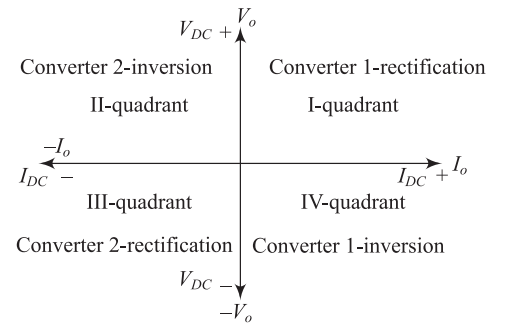
Requirement
Four quadrant converters needed for complete DC motor control
Dual Converters
What are Dual Converters?
Definition
Dual converters consist of two fully controlled converters connected in anti-parallel (back-to-back) configuration to the load circuit.
Key Features:
-
Enable four-quadrant operation
-
Bidirectional voltage and current capability
-
Essential for reversible DC motor drives
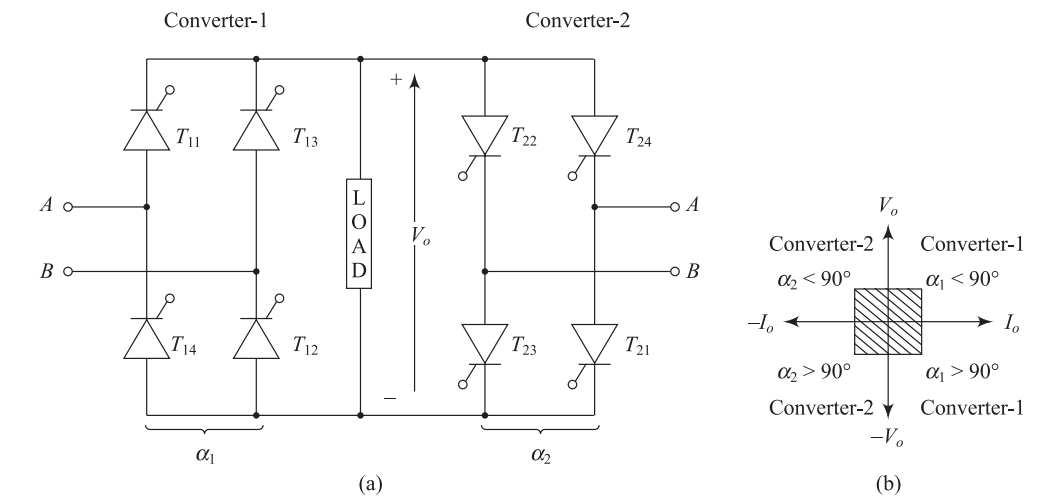
Operating Principle of Ideal Dual Converter
Equivalent Circuit Components
Basic Circuit Elements:
-
Two ideal two-quadrant converters (Converter-1 and Converter-2)
-
Two diodes (\(D_1\) and \(D_2\)) representing unidirectional current flow
-
Load (typically DC motor with back EMF and inductance)
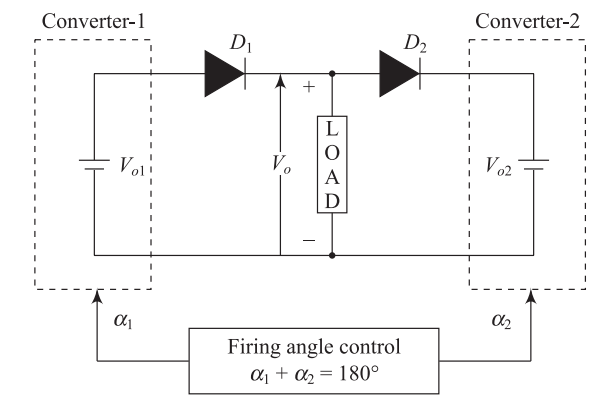
Equivalent Model:
-
Converters modeled as controllable DC voltage sources
-
Diodes in series ensure unidirectional current capability
Assumptions for Analysis
Ideal Conditions:
-
Converters are ideal full converters
-
No ripple in output voltage (pure DC)
-
Negligible converter losses
-
Diodes \(D_1\) and \(D_2\) allow bidirectional current flow
-
Firing angles controlled by control voltage \(V_C\)
Note
These assumptions simplify analysis and help understand fundamental operating principles.
Output Voltage Relations
Voltage Characteristics:
-
\(V_{o1}\) and \(V_{o2}\): average output voltages of Converter-1 and Converter-2
-
Equal in magnitude but opposite in polarity
-
Drive current in opposite directions through the load
Operating Principle:
-
When one converter operates as controlled rectifier, the other operates as inverter
-
Positive group converter: Functions as rectifier
-
Negative group converter: Functions as inverter
Mathematical Relations
Average Output Voltages:
where for a single-phase full converter:
For an ideal converter: \(V_o = V_{o1} = -V_{o2}\)
Fundamental Equation
Firing Angle Control
Control Strategy:
-
Firing angles varied maintaining: \(\alpha_1 + \alpha_2 = 180°\)
-
Ensures equal magnitude but opposite polarity voltages
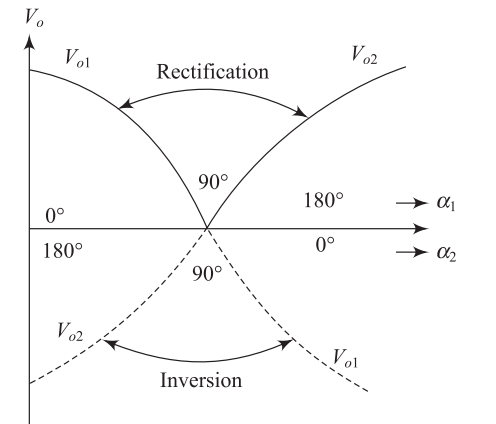
Example:
-
If \(\alpha_1 = 30°\) \(\Rightarrow\) \(\alpha_2 = 150°\)
-
Converter-1: Rectifier mode
-
Converter-2: Inverter mode
-
Practical Dual Converter
Issues in Practical Dual Converter
Challenge: Although average voltages are equal and opposite, instantaneous voltages differ.
Consequences:
-
Instantaneous output voltages \(V_{o1}\) and \(V_{o2}\) are out of phase
-
Voltage difference exists between the two converters
-
Large circulating current flows between converters (not through load)
Solutions:
-
Insert a reactor between converters to limit circulating current
-
Provide appropriate trigger pulses to avoid circulating current
Operating Modes
Two Operating Modes of Practical Dual Converter
Mode 1
Non-Circulating Current Mode
One converter active at a time
Mode 2
Circulating Current Mode
Both converters active simultaneously
Non-Circulating Current Mode
Operating Principle
Key Characteristics:
-
Only one converter operates at any given time
-
Operating converter carries entire load current
-
Active converter receives firing pulses from triggering circuit
-
Idle converter blocked by removing triggering pulses
-
No circulating current flows
-
Reactor not required
Advantage
Eliminates circulating current losses and reactor cost
Circuit Configuration
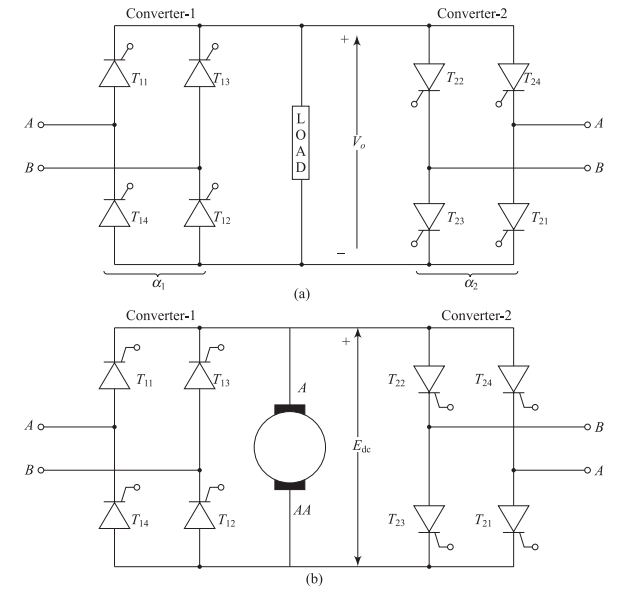
Converter Switching Process
Switching from Converter-1 to Converter-2:
-
Step 1: Remove firing pulses to thyristors of Converter-1
(OR increase firing angle \(\alpha_1\) to maximum value) -
Step 2: Load current decays to zero
-
Step 3: Wait for delay time (10–20 ms)
-
Step 4: Apply triggering pulses to thyristors of Converter-2
-
Step 5: Converter-2 switches ON
-
Step 6: Load current builds up in opposite direction
Critical Requirement
Delay time ensures reliable commutation of thyristors
Delay Time Requirement
Purpose of Delay Time:
-
Delay time: typically 10 to 20 ms
-
Delay between instant when Converter-1 turns OFF and Converter-2 turns ON
-
Ensures reliable commutation of all thyristors in Converter-1
Consequence of Insufficient Delay
If Converter-2 is triggered before Converter-1 completely turns off:
-
Large circulating current flows between converters
-
Potential damage to thyristors
-
System instability
Load Current Characteristics
Current Modes:
-
Load current may be continuous or discontinuous
-
Depends on load inductance and firing angle
Control Circuit Design:
-
Must provide satisfactory performance during both modes:
-
Continuous load current operation
-
Discontinuous load current operation
-
-
Proper current sensing and feedback mechanisms required
Circulating Current Mode
Operating Principle
Key Characteristics:
-
Both converters in operating condition simultaneously
-
One converter operates in controlled rectifier mode
-
Other operates in inverting mode
-
Reactor inserted between Converter-1 and Converter-2
-
Reactor limits amplitude of circulating current to acceptable value
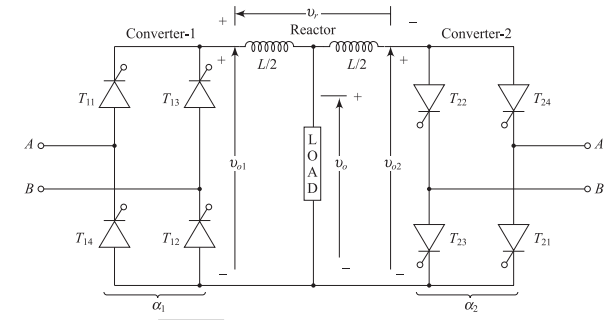
Firing Angle Control
Control Law: \(\alpha_1 + \alpha_2 = 180°\) always satisfied
Example: If \(\alpha_1 = 45°\), then \(\alpha_2 = 135°\)
-
Converter-1 operates as controlled rectifier (\(\alpha_1 < 90°\))
-
Converter-2 operates as inverter (\(\alpha_2 > 90°\))
Voltage Characteristics:
-
Average values of \(V_{o1}\) and \(V_{o2}\) are equal
-
Instantaneous values of \(V_{o1}\) and \(V_{o2}\) differ
-
Voltage difference causes circulating current
Critical Component
Reactor (inductor) is essential to limit circulating current
Voltage Waveforms
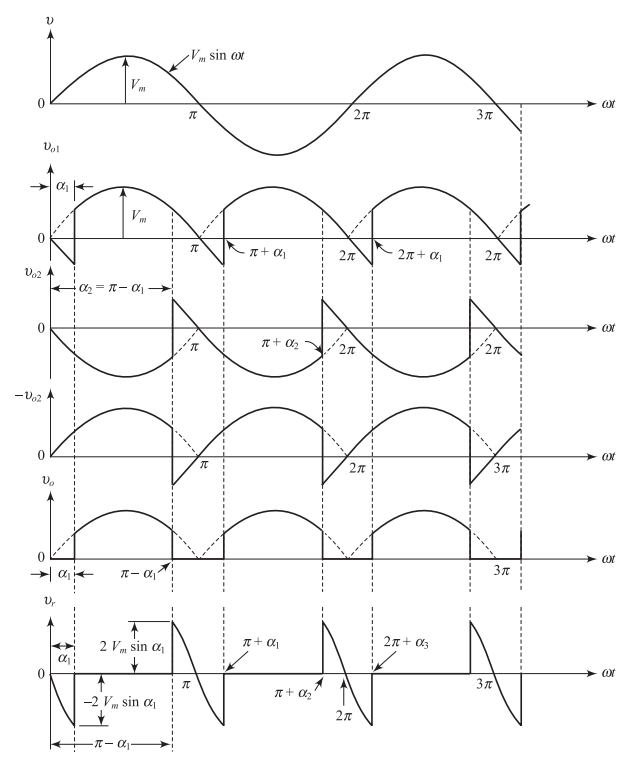
Load Current Reversal
Reversal Process:
-
Load current reversed by interchanging roles of two converters
-
Converter-1 switches to inverter mode (\(\alpha_1 > 90°\))
-
Converter-2 switches to rectifier mode (\(\alpha_2 < 90°\))
-
Equation \(\alpha_1 + \alpha_2 = 180°\) always satisfied
Advantage
-
Normal delay time (10–20 ms) not required
-
Instantaneous current reversal possible
-
Operation of this type of dual converter is faster
-
Better dynamic response
Comparison of Operating Modes
Non-Circulating vs Circulating Current Mode
| Parameter | Non-Circulating | Circulating |
|---|---|---|
| Converters active | One at a time | Both simultaneously |
| Circulating current | Zero | Present |
| Reactor required | No | Yes |
| Switching delay | 10–20 ms | Negligible |
| Response speed | Slower | Faster |
| Efficiency | Higher | Lower |
| THD rating | Lower | Higher |
| Cost | Lower | Higher |
Disadvantages of Dual Converters
Disadvantages
Major Drawbacks:
-
Reactor size and cost
-
Required to limit circulating current
-
Size and cost significantly high at high power levels
-
Adds weight and volume to the system
-
-
Low efficiency and power factor
-
Due to losses from circulating current
-
Increased copper and core losses in reactor
-
-
Higher thyristor current rating
-
Must handle both load current and circulating current
-
Increases device cost
-
-
Complex control system
-
Requires precise firing angle coordination
-
When to Use Circulating Current Mode
Despite disadvantages, circulating current mode dual converter is preferred when:
Application Requirements
-
Load current needs to be reversed frequently
-
Fast response four-quadrant operation is required
-
Dynamic performance is critical
-
No time delay can be tolerated during reversal
Typical Applications:
-
Reversible rolling mill drives
-
High-performance servo systems
-
Rapid transit systems
Summary
Key Points
-
Dual converters enable four-quadrant operation for DC motor drives
-
Consist of two fully controlled converters connected back-to-back
-
Fundamental relation for ideal dual converter: \(\boxed{\alpha_1 + \alpha_2 = 180°}\)
-
Two operating modes available:
-
Non-circulating current mode: One converter active, no reactor
-
Circulating current mode: Both converters active, reactor required
-
-
Non-circulating mode: Higher efficiency, slower response
-
Circulating mode: Faster response, higher losses
-
Choice depends on application requirements
-
Essential for reversible DC motor control applications